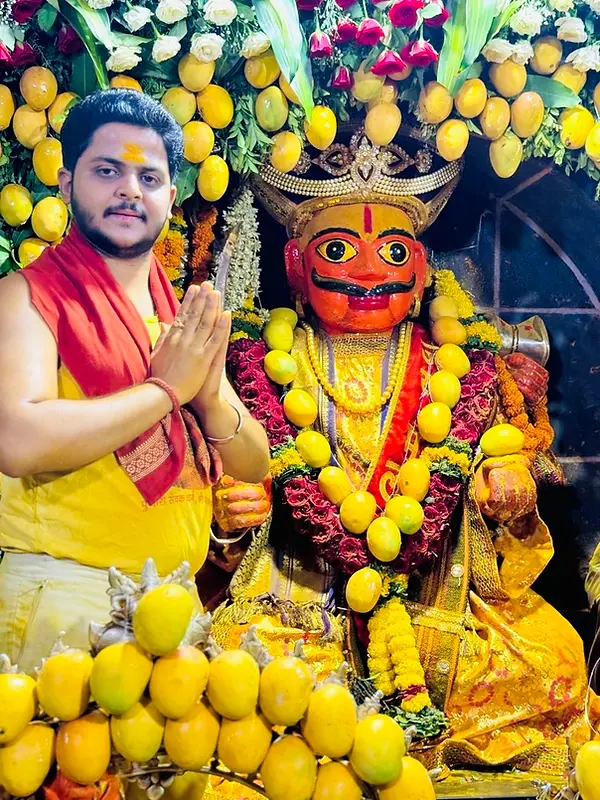
The Mardani Dussehra in Jejuri is a very energetic, traditional and religious festival. From the palanquin ceremony of Khandoba to the eighteen-hour religious and cultural programs, the entire Jejuri is awake on this day.
🔸 Beginning of the ceremony:
The palanquin ceremony begins at 6 pm on the day of Dussehra. The palanquin is carried along the path amidst the cheers of the Khandoba, the blowing of the bhandara, and the bursting of firecrackers. The palanquin reaches the traditional place of Susartingi.
🔸 Kadepathar Ceremony:
At 9 pm, the second palanquin departs from the Kadepathar hills. At 12:30 pm, Apta Pujan is performed, and then between 1 and 2 am, the Devbheti ceremony is held in Ramna. After this, Apta Pujan is performed again in Ramna at 2:30 pm.
🔸 Cultural and artistic events:
When the palanquin returns to the village, it is welcomed with fireworks, rangoli and flower decorations, and the playing of the clarinet and drums by the Ghadashi community. Lavani, traditional padas, Khandoba songs, ragdari, and theatrical songs are performed. Folk artists perform in front of the palanquin at the fort.
🔸 Masculine competition:
This festival also features competitions that showcase the power of bravery, such as:
1. Sword Weighing Competition
2. Khanda lifting competition
🔸 Conclusion:
The entire eighteen-hour ceremony culminates at Khandoba Fort in the early morning, where devotion, valor, tradition, and unity are exemplified.

🌼 Champashashthi Festival at Jejuri Fort – A blend of devotion, tradition and spiritual energy
The grand conclusion of the Champashashthi festival of Shri Khandoba, the ancestral deity of Maharashtra, was recently celebrated in a devotional atmosphere at Jejuri Fort. Lakhs of devotees from across the state attended this six-day religious festival.
🔸 Telhanda procession and traditional rituals
On Margashirsha Panchami, on Sunday evening, a procession of oil pots was taken out from the fort in the traditional manner by the Gurav, Koli, Veer, and Gadshi sevakars. The oil offered by the devotees and the dignitaries was used to anoint Shri Khandoba and Mhalsa Devi with oil and turmeric. The procession went to Chavdi, where the names of the dignitaries were called out and oil was offered.
🔸 The main day of Champashashti and the conclusion of the ceremony
On Monday, the day of Champashtami, the energy at the fort reached its peak. The fort was illuminated with attractive electric lights, a procession decorated with flowers, and the chanting of thousands of devotees, during which the deity idols were anointed and a special offering (Bharit-Rodga) was offered. On this day, the six-day Ghat of Khandoba was dissolved and preparations began for the Devavivah, which would take place on the Posh Purnima.
🔸 Presence of devotees from all over the state
Lakhs of devotees from all over Maharashtra including Pune, Satara, Konkan, Solapur, Mumbai, Nagar, and others, completed their rituals by taking darshan with their families. Every moment at the fort was filled with the spirit of faith, tradition, and devotion.
📜 In short:
Champashashthi Festival 2025 was an unforgettable experience — traditional rituals, crowds of devotees, the smell of turmeric and the procession of oil pots all lit up Jejuri fort with devotion once again. Thousands of devotees came together to celebrate this religious, cultural and spiritual festival with great devotion, seeking the blessings of Shri Khandoba.
This is not just a ceremony – it is an eternal tradition of faith in Maharashtra.

🌑 On the day of Somvati Amavasya, an ocean of devotion rises at Jejuri Fort...
The fort is thronged with devotees in the morning itself. The chants of "Sadanandacha Yelkot! Jai Malhar!" grow louder every moment. The golden rain of Bhandara turns the entire area yellow — as if the golden jewels were truly realized.
🔸 The palanquin ceremony begins in the afternoon...
At 1 pm, a special stir is felt at the fort. There is curiosity in the eyes of the devotees. The festive idols reach the shrine. The Gurav priests ritually place the idols in the palanquin. The shoulder-bearers get ready to lift the palanquin. The Peshwa's signals and the sound of gunfire echo over the fort — as if it is the beginning of a royal offering!
🔸 The path outside the fort – a sacred journey
The palanquin descends the steps, the sky is covered with the blare of the bhandara. As we cross the path, Chinchbagh, Gautameshwar, Janubai Chowk, Shivaji Chowk — every place is decorated by devotees. The atmosphere is filled with flower petals, rangolis, the sound of drums and tambourines, and the performance of songs.
🔸 Bathing in the Kanha River – A confluence of purity and devotion
At 5 pm, the ceremonial bathing of the idol of the deity takes place in the Kanha River. Every drop of the water immersion is imbued with the sacredness of devotion and faith. Thousands of devotees close their eyes and cherish the memory of that moment in their minds.
🔸 Return to the fort – a stop for the day's devotion
After bathing, the palanquin returns to the fort. As darkness falls, the fort is illuminated with bright lights, fireworks, and the chanting of Jai Malhar once again adds to the atmosphere. This is not just a religious festival — it is a journey of emotions, tradition, and spiritual energy.
🔚 In short:
The Somvati Amavasya festival in Jejuri is a unique experience — where pure devotion, traditional royalty, and folk sentiment come together. The respect given to Khanderaya's palanquin, the public participation, and the celebration of faith that erupts at the fort — all of this gives you a different spiritual energy.
Even if you weren't there, the experience lingers in your mind – and once you see this Jejuri ceremony, you'll want to go again every year!








